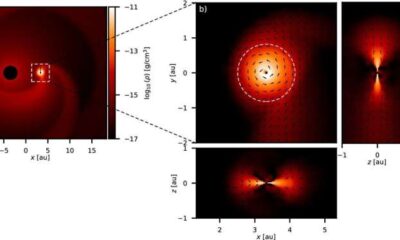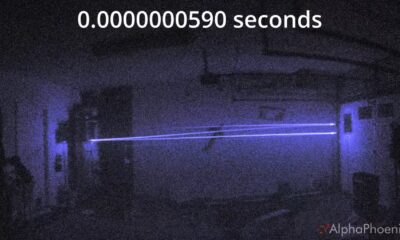Science
Interstellar Object 3I/ATLAS Emits Unique Metal Alloy, Say Scientists

A recent analysis of the interstellar object 3I/ATLAS has revealed that it is emitting a metal alloy never before observed in nature. According to Harvard astrophysicist Dr. Avi Loeb, new images captured by the Keck II Telescope in Hawaii show that this object is releasing a plume containing four grams of nickel per second, without any detectable iron. This phenomenon is unprecedented, particularly for a comet.
The alloy being produced, known as nickel tetracarbonyl, has only been seen in industrial processes on Earth. Dr. Loeb, who serves as a professor of theoretical physics at Harvard and is the director of the Center for Astrophysics, emphasized the rarity of this observation. He stated, “There is only one place where that is known to exist and that is in industrially produced nickel alloys.”
Unique Characteristics of 3I/ATLAS
Another intriguing aspect of 3I/ATLAS is its lack of a typical cometary tail. Dr. Loeb noted that comets usually display prominent tails directed away from the Sun, but in this case, there is no evidence of such a feature. Instead, images from the Hubble Space Telescope have shown a stream of materials—approximately 330 pounds per second—flowing toward the Sun.
“Why are we seeing a jet pointed at the Sun? A stream of material in the direction of the Sun?” Dr. Loeb questioned, highlighting the unusual nature of the object’s behavior. The material primarily consists of carbon dioxide and water, with trace amounts of cyanide and nickel, but notably lacks iron.
As astronomers continue to investigate this remarkable object, skywatchers around the world are eager for more data. The Mars Reconnaissance Orbiter has been capturing images of 3I/ATLAS from October 4 to October 7, 2025, but the release of these images has been delayed due to a government shutdown affecting NASA’s communications department. Dr. Loeb expressed frustration over this delay, asserting, “Who cares about the communication departments? We want to see the data from the scientists.”
Implications of the Discovery
The discovery of nickel tetracarbonyl in a natural setting provides scientists with a unique opportunity to explore materials and processes that have only been previously associated with human activity. This could potentially reshape our understanding of interstellar objects and their compositions.
The interest surrounding 3I/ATLAS is not just scientific; it also captures the public’s imagination. As data continues to emerge, the implications of such findings could extend far beyond the realm of astronomy, influencing various fields such as materials science and manufacturing.
The excitement surrounding this interstellar visitor underscores the importance of international collaboration in space exploration. As researchers around the globe eagerly await further observations, the scientific community remains hopeful that continued study of 3I/ATLAS will yield more groundbreaking discoveries.
-

 Science1 month ago
Science1 month agoOhio State Study Uncovers Brain Connectivity and Function Links
-

 Politics2 months ago
Politics2 months agoHamas Chief Stresses Disarmament Tied to Occupation’s End
-

 Science1 month ago
Science1 month agoUniversity of Hawaiʻi Joins $25.6M AI Project for Disaster Monitoring
-

 Entertainment1 month ago
Entertainment1 month agoMegan Thee Stallion Exposes Alleged Online Attack by Bots
-

 Science4 weeks ago
Science4 weeks agoALMA Discovers Companion Orbiting Giant Star π 1 Gruis
-

 Science2 months ago
Science2 months agoResearchers Challenge 200-Year-Old Physics Principle with Atomic Engines
-

 Entertainment1 month ago
Entertainment1 month agoPaloma Elsesser Shines at LA Event with Iconic Slicked-Back Bun
-

 World1 month ago
World1 month agoFDA Unveils Plan to Cut Drug Prices and Boost Biosimilars
-

 Business1 month ago
Business1 month agoMotley Fool Wealth Management Reduces Medtronic Holdings by 14.7%
-

 Top Stories2 months ago
Top Stories2 months agoFederal Agents Detain Driver in Addison; Protests Erupt Immediately
-

 Entertainment1 month ago
Entertainment1 month agoBeloved Artist and Community Leader Gloria Rosencrants Passes Away
-

 Science2 months ago
Science2 months agoInnovator Captures Light at 2 Billion Frames Per Second








